Moving to Graz, Austria
Welcome to Graz: Green tech energy, Old Town charm, student buzz.
Austria’s second-largest city blends a UNESCO-listed medieval core with a forward-looking tech scene powered by universities, green innovation and advanced manufacturing. As of 1 January 2025, Graz counts about 306,000 residents, with a distinctly international profile, and more than 60,000 students across its higher-education institutions, which keeps the city youthful, creative and highly skilled.
For tech professionals, the industrial backbone is unusually strong for a mid-sized European city. Global mobility engineering leader AVL is headquartered here and continues to invest in high-performance testing and simulation facilities at its Graz campus. Contract car maker Magna Steyr runs one of Europe’s best known vehicle plants in the city. Infineon’s Austrian R&D network includes Graz competencies in secure, contactless and automotive technologies, feeding into the region’s electronics and software ecosystem. These anchors create a tight loop between applied research, prototyping and career opportunities in automotive, e-mobility, semiconductors, embedded security and digital simulation.
Graz also sits at the heart of two powerful innovation brands. The Silicon Alps cluster ties together electronics and software based systems across Styria and Carinthia, while Green Tech Valley positions the Graz area as a European hotspot for climate tech and clean technologies. Together they support startups, SMEs and corporates with networking, research partners and access to pilot infrastructure. For those looking to join or found a startup, Science Park Graz serves as the region’s high-tech incubator and operates the ESA Business Incubation Centre for Southern Austria. Recent mapping of Austria’s green tech startups highlights Vienna and Graz as the dominant hubs.
Talent pipelines are deep and international. TU Graz alone has 13,500 students with more than a quarter from abroad and a growing portfolio of English-taught programs. The University of Graz enrolls close to 30,000 students, and the city’s arts and applied sciences universities round out a comprehensive campus ecosystem that spans engineering, data, design and health. For employers, that means steady access to graduates in software, data, electronics, and human-centered design. For newcomers, it means a lively calendar of meetups, labs and research projects to plug into from day one.
Quality of life is a major draw. Graz’s compact layout, extensive tram and S-Bahn links, and strong cycling culture make car-free living practical. Academic research notes a roughly 20 percent mode share for both cycling and public transport, and the Old Town, Schlossberg and contemporary icons like the Kunsthaus add daily inspiration. Food lovers get farmers’ markets and Styrian wine country on the doorstep. For relocating families and professionals, this translates into short commutes, a relaxed pace and plenty of green space, without giving up a serious tech career path.
Lifestyle and Culture
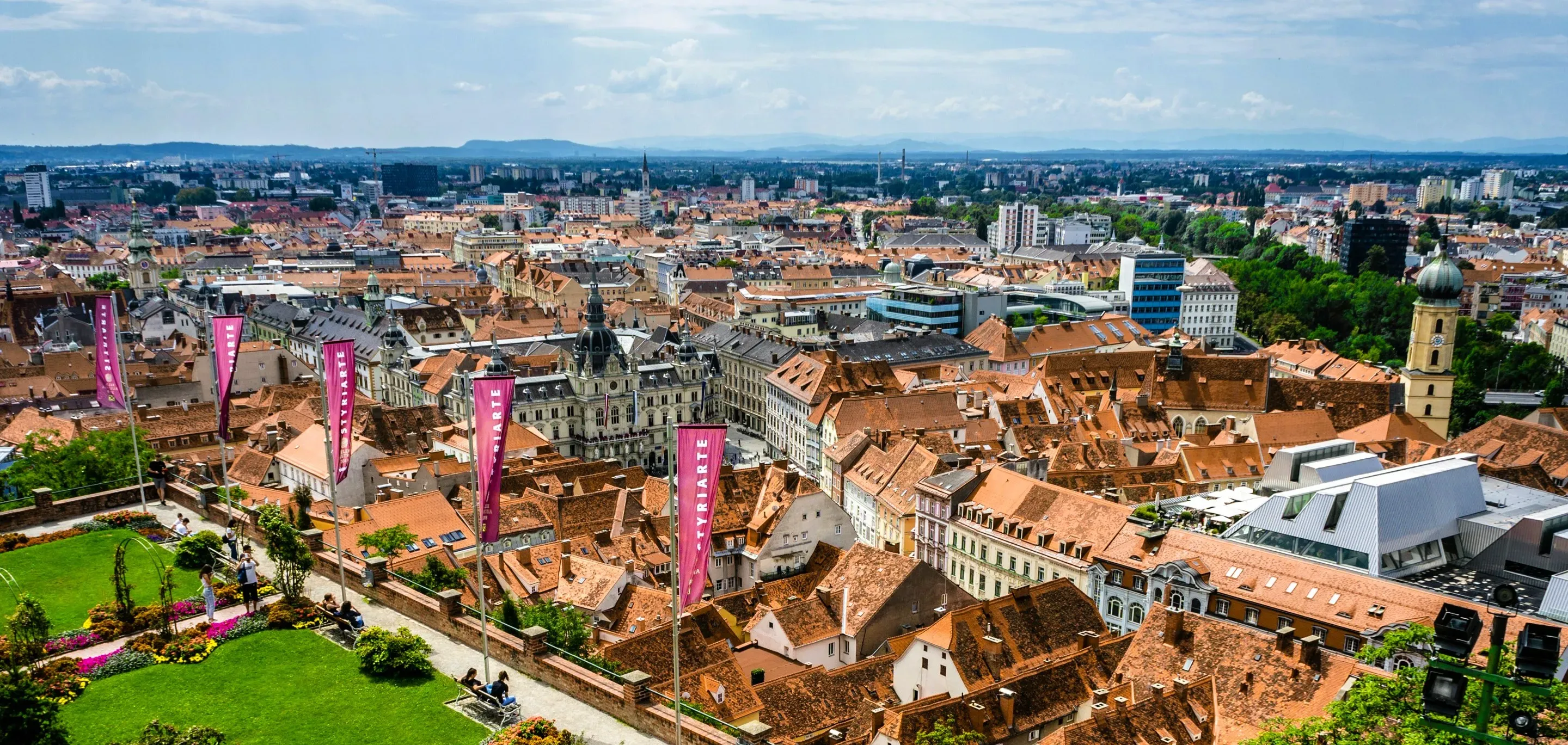
City lifestyle
Graz is a compact, outdoorsy university city with a relaxed, southern feel, where café terraces fill early and stay lively late, especially around the Old Town and the creative Lend side of the river. The city’s UNESCO badges tell the story: a World Heritage historic center plus Eggenberg Palace, and a City of Design designation that nurtures a strong creative scene and contemporary architecture. Expect easy-going days, strollable streets, and a culture that blends Renaissance courtyards with cutting-edge design.
Public life revolves around markets, parks and the river. Locals stock up at Kaiser-Josef-Markt or Lendplatz farmers’ market, then meet friends for coffee, wine or a spritzer. Trams and buses make car-free living simple within zone 101, and the Stadtpark, Schlossberg and Botanical Garden put generous green right in the middle of town. The overall vibe is social yet unhurried, with a big student presence that keeps things curious and collaborative.
Culturally, Graz mixes an Italianate old town atmosphere with bold contemporary icons like the blob-shaped Kunsthaus and the LED-glowing Murinsel footbridge and café. That contrast between centuries-old arcades and playful new forms is part of everyday life here.
Cultural highlights and attractions
- UNESCO Old Town and Schloss Eggenberg. Wander from arcaded courtyards and Baroque façades up to the clock-topped Schlossberg, then hop a tram to Eggenberg Palace and its gardens, part of the same UNESCO listing.
- Kunsthaus Graz. The “Friendly Alien” shows rotating contemporary art and lights up at night with its BIX media façade. It anchors the cultural life of the Lend riverside.
- Murinsel. A sculptural island bridging both banks of the Mur, created for the 2003 Capital of Culture year, now a beloved spot for coffee and evening color shows.
- Styrian Armoury. The world’s largest preserved historical armoury, with some 32,000 pieces from the 15th to 18th centuries.
- Clock Tower on the Schlossberg. Graz’s emblem with quirky “reversed” hands, plus sweeping city views.
Festivals and traditions
- La Strada transforms streets and squares into a stage for contemporary circus, puppetry and public-space art each summer.
- Aufsteirern turns the city center into a celebration of Styrian folk culture each September, with regional foods, crafts and Tracht.
- springfestival brings electronic music, art and design citywide every June, from Dom im Berg to clubs and parks.
- Advent in Graz. In winter the linked Christmas markets fill the old town, including WonderLEND on Mariahilferplatz, all within walking distance.
Popular neighborhoods
- Lend. Creative and multicultural, with street art, independent shops, Lendplatz farmers’ market and nightlife near the Kunsthaus and Murinsel. Handy for tech professionals commuting to AVL HQ on Hans-List-Platz or Infineon’s Graz site across the river. Expect older walk-ups, renovated lofts and new builds in side streets.
- Geidorf. Leafy university quarter north of the center, popular with researchers and families who want parks and easy access to the University of Graz, Botanical Garden, and the Hilmteich-Leechwald green belt. Mostly period apartments and townhouses, some modern infill.
- St. Leonhard. Calm, residential streets close to the Opera and University clusters, plus the University Hospital Graz. Good for professionals who want walkable culture and a short ride to the center. Mix of classic Gründerzeit buildings and newer apartments.
- Jakomini. The city’s tram crossroads with quick links anywhere. Close to theatres, shops and the stadium side of town. Suits young professionals who value connectivity and urban convenience. Mostly apartments in older blocks and recent refurbishments.
- St. Peter. Residential, green and close to TU Graz’s Inffeldgasse campus and Science Park Graz, which makes it ideal for engineers, data specialists and founders who want a short commute to labs and incubators. Housing skews to mid-century blocks and low-rise new builds.
- Eggenberg. More space for the money and direct tram to the UNESCO-listed palace park. Good for families seeking greenery without leaving the city. Mix of 20th-century apartments and newer developments.
- Mariatrost. A tranquil hillside setting crowned by its baroque basilica, with hiking at the doorstep and tram access toward the center. Primarily single-family homes and small multifamily houses.
- Andritz. Northerly, green and village-like in parts, with quick escapes toward the Schöckl foothills. Attractive for families wanting space, bike paths and nature. Housing ranges from houses with gardens to modern low-rise.
Cost of Living
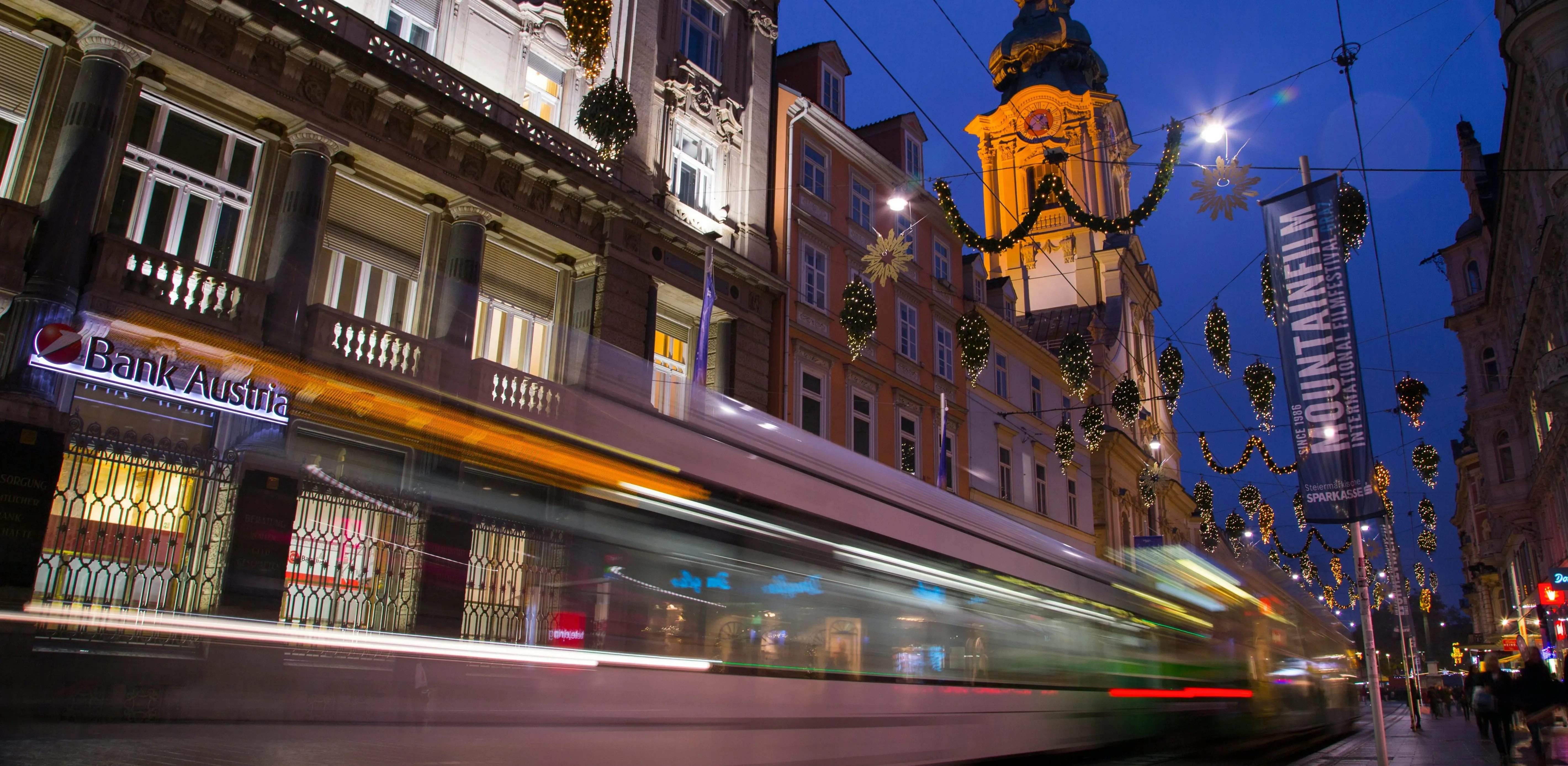
Below is a practical snapshot of everyday costs in Graz as of October 2025, with recent, city-specific sources. Approximate ranges are included to help sanity-check a budget quickly.
Breakdown of major expenses
Housing
- Typical market rents in the city run around 14.0 € per m² per month in 2025, up about 2.4 percent year on year. That translates roughly to 700–900 € for a compact 50–65 m² one-bedroom, depending on neighborhood and condition.
- Real-world listings and crowd-priced datasets align with that ballpark: recent aggregates show 1-bedroom flats at about 590–950 € depending on inside or outside the center, and 3-bedroom flats about 920–1,750 € in the center.
Utilities
- A bundled estimate for electricity, heating, cooling, water and garbage for an 85 m² flat in Graz is around 180 € per month. Austria’s residential electricity price was about 0.369 € per kWh in March 2025 for kWh-based planning.
Internet and mobile
- Home internet for 60–300 Mbps typically lands around 30–50 € per month in Graz, based on recent price snapshots and user-reported plans.
Public transport
- A single ride in zone 101 is 3.20 €. A 24-hour ticket is 7.00 €. With a registered main residence in Graz, the subsidized annual pass is 315 € for unlimited rides in zone 101, effectively about 26 € per month.
Groceries
- Everyday basket items at major Austrian chains sit roughly at: 1 l long-life whole milk 1.19–1.69 €, organic lines around 1.59–1.99 €, with periodic promotions below this.
- Crowd-priced platforms place a standard grocery basket for Graz in line with these tags, with milk, bread and staples priced close to the Austrian average.
Eating out, coffee and entertainment
- Cinema tickets are typically around 12–13.50 € per adult seat, or ~24 € for two.
- A fast-casual combo meal averages about 11 €; a mid-range dinner for two starts around 40–60 € depending on drinks.
Health insurance
- Employees are mandatorily insured through Austria’s public system, with the employee contribution withheld from payroll. In 2024 the employee health-insurance rate was 3.87 percent of gross salary, a solid guidepost for 2025 budgeting. For marginal employment, voluntary self-insurance runs about 77.81 € per month in 2025.
Childcare
- Public kindergarten placement is free to apply for, though monthly parental contributions vary by municipality and provider. As a planning anchor, private kindergarten fees often fall in the 250–400 € per month range in Austria, with Graz broadly consistent. Always confirm with the specific Träger.
Inflation context
- Austria’s inflation was running about 4.0 percent year on year in September 2025, which feeds into annual price adjustments on services and new tenancy offers.
How Graz compares
Versus Austria overall
- Austria’s average rent including running costs was 10.2 € per m² in Q2 2025. Graz’s market level around 14 € per m² shows why the city is pricier than the national mean, though still below Vienna’s hottest districts.
- Household electricity prices are national, so Graz households pay similar per-kWh rates to the rest of Austria.
Versus Vienna and other European hubs
- Vienna remains more expensive overall. Recent comparisons suggest rent prices in Vienna are roughly 48 percent higher than in Graz, and cost of living including rent is about 10 percent higher in Vienna.
- Compared with Munich, living in Graz including rent is roughly 22 percent lower on current crowd-sourced indices. Zurich is in a different league entirely, with total costs including rent about double Graz levels.
Average Salaries in Tech
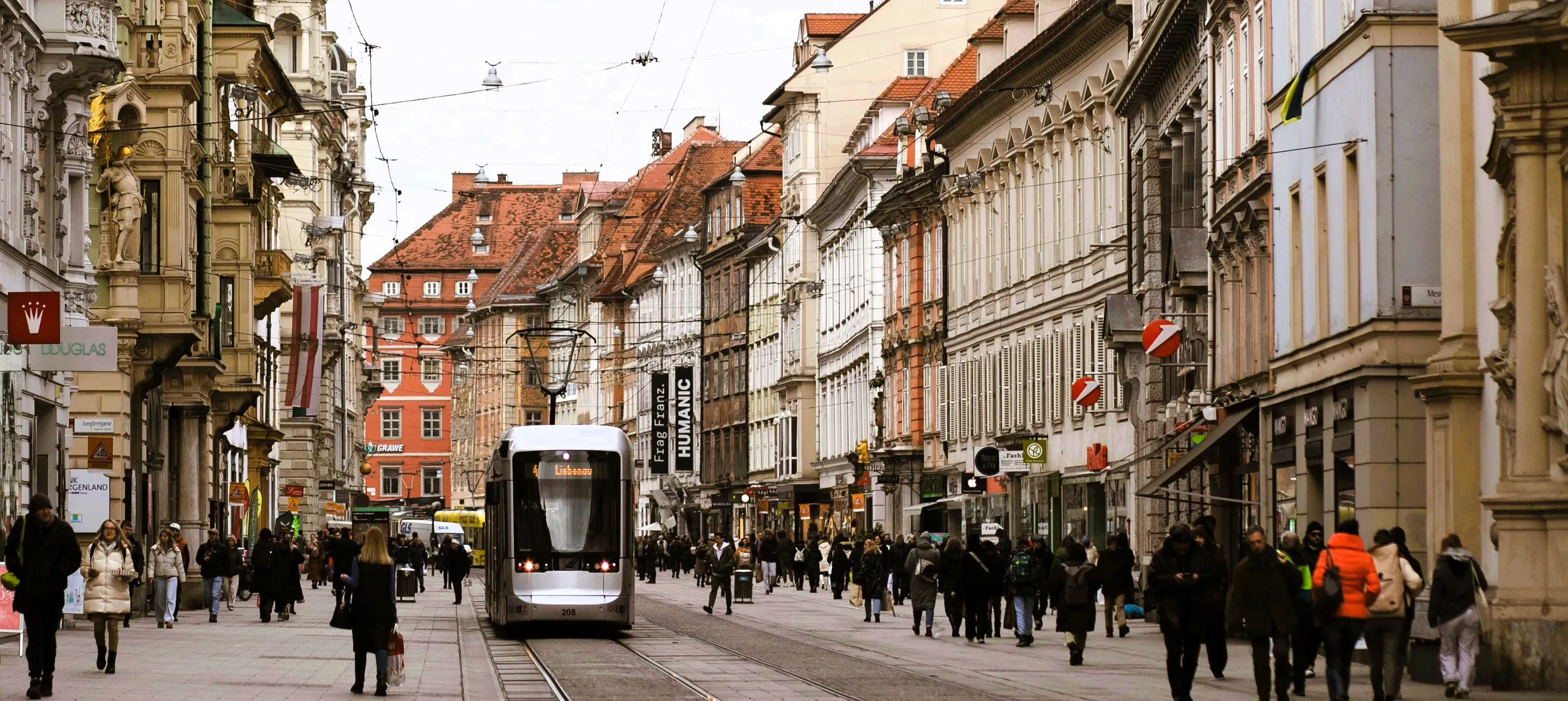
Realistic 2025 ranges for Graz, grouped by seniority to help benchmark offers quickly. Figures are gross yearly and reflect total pay where sources allow.
Salary ranges by role
Software Engineer / Developer
-
Entry level: €46,000 to €55,000
-
Mid level: €55,000 to €70,000
-
Senior: €70,000 to €92,000
Crowd-reported Graz data shows an average near €53,000, with a 25th–75th band around €46,000–€65,000. Median total comp near €63,700, with senior upper quartiles above €79,000.
Embedded Software Engineer
-
Entry level: €44,000 to €52,000
-
Mid level: €52,000 to €70,000
-
Senior: €70,000 to €85,000
Graz embedded roles align with the city’s automotive and electronics scene. Local averages cluster around €62,500, with a 25th–75th span roughly €54,000–€75,000.
DevOps Engineer
-
Entry level: €50,000 to €58,000
-
Mid level: €58,000 to €70,000
-
Senior: €70,000 to €85,000
Graz samples show averages near the mid 50s, with experienced roles commonly reaching the low to mid 70s.
Data Scientist
-
Entry level: €50,000 to €58,000
-
Mid level: €58,000 to €70,000
-
Senior: €70,000 to €90,000
Local datapoints cluster in the high 50s to low 60s on average, with national senior figures higher in Vienna and corporate R&D hubs.
Data Analyst
-
Entry level: €40,000 to €48,000
-
Mid level: €48,000 to €60,000
-
Senior: €60,000 to €70,000
Austria-wide medians for data analysts sit around €45,000 to €61,000 depending on dataset and seniority, which maps well to Graz offers.
QA and Test Engineer
-
Entry level: €42,000 to €48,000
-
Mid level: €48,000 to €60,000
-
Senior: €60,000 to €80,000
Recent Graz reports show averages near €50,500, with a 25th–75th span around €43,000–€60,000.
How Graz compares
Versus Austria overall
- For core software roles, Graz sits slightly below Austria-wide medians at junior levels, then converges by mid level. Austria’s median software engineer total comp is around €65,000, and Graz’s median is roughly €64,000.
- Austria’s cross-industry average full-time salary is roughly €50,600, so many Graz tech roles clear the national average.
Versus Vienna and nearby hubs
- Vienna typically pays 5 to 10 percent more for comparable software roles. Vienna software developer medians are about €59,000 versus roughly €53,000 in Graz.
- Munich and Zurich pay more, but cost of living and commuting time are also higher, which narrows real take-home comfort once expenses are considered.
Notes that matter when negotiating
- Many Austrian tech employers pay 14 salaries per year. Always confirm whether a quoted figure is per 12 or 14 payments.
- Collective agreements set legal minimums by industry. University and public research posts publish base pay publicly, with TU Graz listings often showing minimums near €52,000 for certain research roles, with overpayment possible.
- Inflation in 2024 and 2025 led to upward adjustments in many sectors. Bands may move a few percent year on year, and offers may include meal subsidies, public transport passes or relocation support.
Family-Friendliness
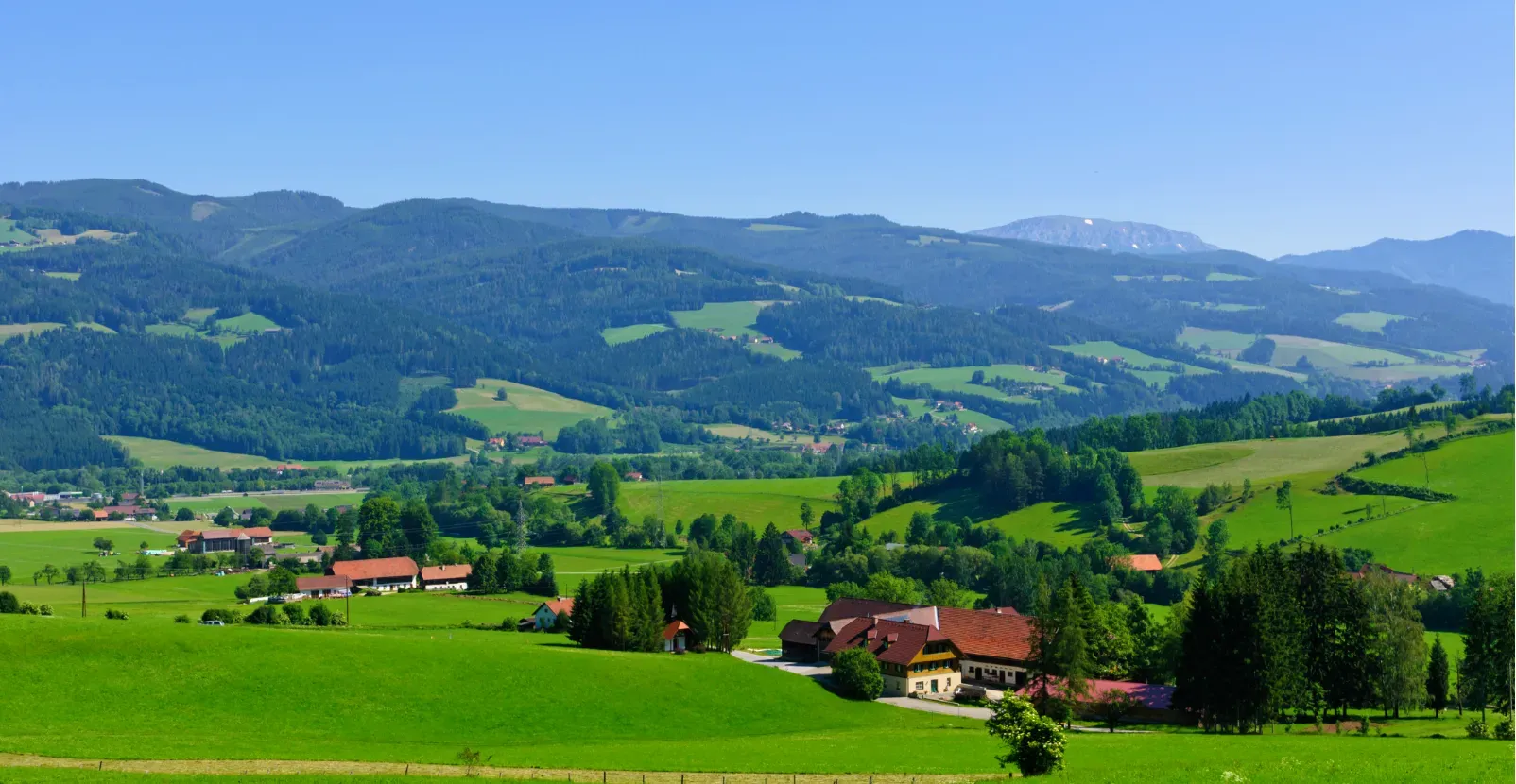
Overview of family services
Healthcare you can rely on
Graz is a university medical city. The LKH–University Hospital Graz is one of Austria’s largest, with specialist pediatric care, English information for patients and relatives, and a green campus that is easy to navigate. Primary care and pediatric practices are widely available, and expectant parents can tap into city and non-profit advice centers for prenatal and postnatal support. For national guidance on benefits and paperwork, the federal portal explains entitlements in plain English.
Childcare and kindergarten
Places for crèche, kindergarten and after-school care are allocated through the Styrian online portal during a published window each winter. The City of Graz confirms that pre-registration is exclusively online and lists the current timetable each year, which makes planning easier if relocation happens mid-school-year. National guidance covers typical fees and clarifies that enrollment itself is free, with monthly parental contributions set by the provider or municipality.
Playgrounds, parks and pools
More than 70 public playgrounds are maintained by Holding Graz, alongside generous green space from the central Stadtpark to the Hilmteich–Leechwald woods for weekend adventures. When the weather turns hot, families head to the Auster sports pool in Eggenberg or other public pools across the city.
Financial support for parents
Austria offers a childcare allowance available as a flat-rate or income-related option, with rules, durations and application steps outlined on the federal portal. The University of Graz Family Service also summarizes local contacts and hotlines, including the nationwide childcare allowance info line.
Family advice and welfare
If needed, the City of Graz Child and Youth Welfare Service provides counseling and practical support for families with children under 18, with an English brochure that explains how to get help.
Schooling options
Public schools with strong English tracks
• Graz International Bilingual School (GIBS) serves ages 10 to 18 with a German–English program and international ethos. Admissions are competitive, so early planning is advised.
• BIPS-Krones (Bilingual Primary School) is a city primary school that teaches the Austrian curriculum in German with strong daily English. It is state funded, has no tuition, and requires residence in Graz.
Early years and after-school care
Crèches, kindergartens and Horte (after-school care) are standard offerings. The City of Graz routes pre-registration through the Kinderportal Steiermark and publishes precise dates each year. If arrival falls outside the main window, providers and the city can advise on waitlists.
Enrichment and science play
The FRida & freD Children’s Museum in Augarten runs hands-on exhibitions in English and German for ages 3 and up, plus workshops well-suited for rainy days.
Parks, play and weekend ideas
In the city
Start with the Stadtpark for open lawns and play areas, then head north to Hilmteich–Leechwald for lakeside paths, forest trails and kid-friendly circuits. Many playgrounds are shaded and distributed through residential districts, so one is usually within a short walk.
Swim and splash
The Auster complex in Eggenberg offers indoor and outdoor pools, slides and a family zone, with lane swimming for older kids. The city tourist site lists other public pools, including the architectural Bad zur Sonne in the center.
Getting around
Families who register a main residence in Graz can ride all year in zone 101 for a flat 315 euros with the annual pass. Strollers are common on trams and buses, and most stops are curb-level.
Appealing features for families
- Short, simple routines. Schools, shops, playgrounds and medical care sit close together, keeping daily logistics manageable even with small children. The dense tram network supports car-light living.
- Education with language support. Between GIBS at secondary level and BIPS at primary level, English-speaking children can integrate without losing their language.
- Abundant green space. Quick micro-adventures are normal in Graz, from feeding ducks at Hilmteich to a picnic in Stadtpark, with more than 70 playgrounds to rotate through.
- Cultural playfulness. FRida & freD’s interactive exhibitions make museum visits engaging for kids, and seasonal festivals keep weekends lively.
- Clear benefits and entitlements. Federal childcare allowance options are transparent, with English-language guidance and helplines that reduce paperwork stress.
Relocation Resources
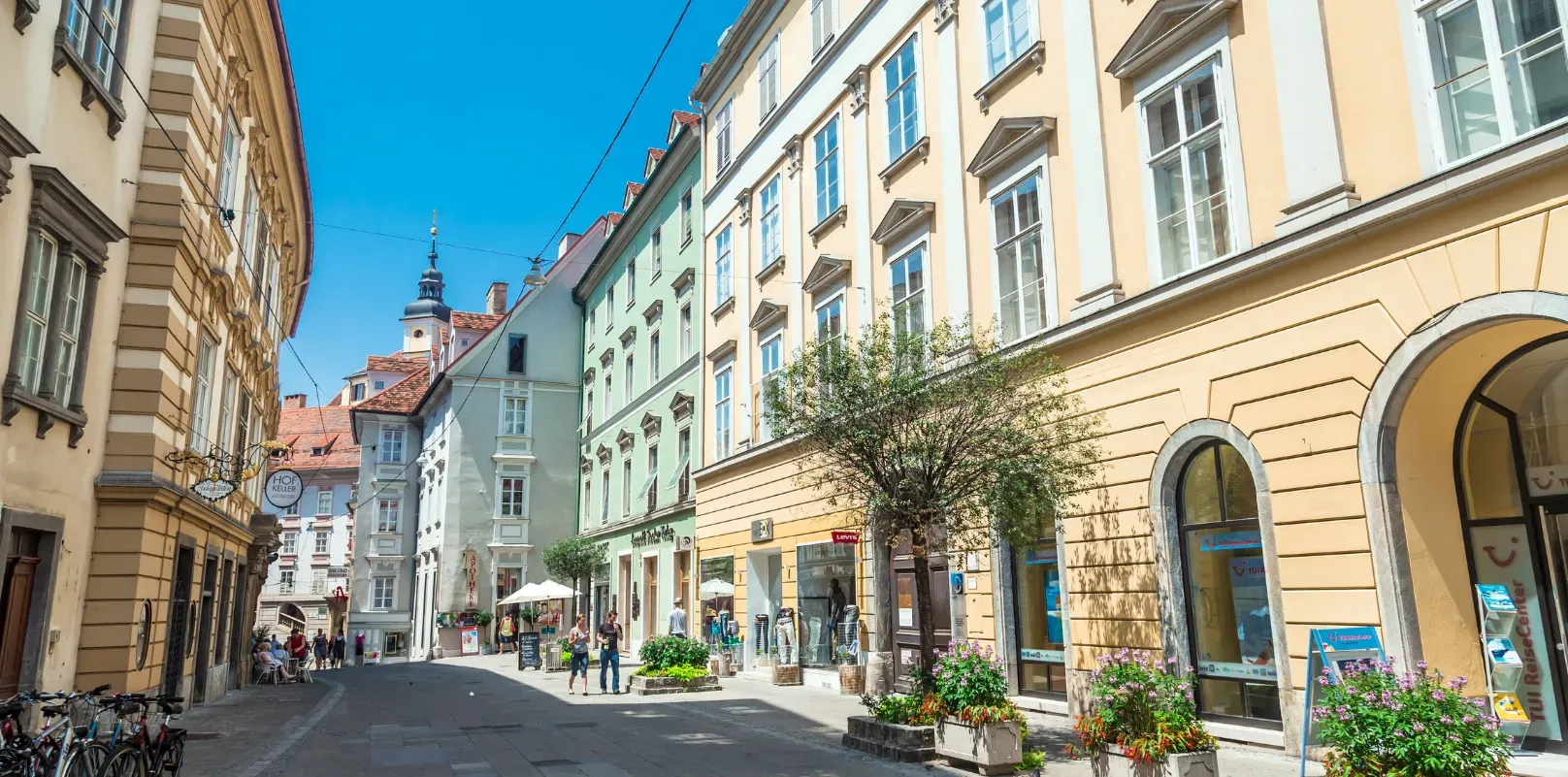
Below are dependable, Graz-specific resources for finding housing and getting settled, grouped by use case to move from a temporary landing pad to a proper lease with minimal friction.
Short stays and “landing pads” for the first weeks
- University guest apartments. For researchers or visiting staff, the University of Graz guest apartments and TU Graz Guest House offer short stays coordinated through the host department. Availability is limited, but convenience is high.
- Furnished month-to-month. Flexible arrivals benefit from furnished stays with utilities included. Airbnb’s monthly options for Graz help compare neighborhoods and prices before committing to a lease.
- Apart-hotels. Local serviced options such as Graz Rentals can bridge a few weeks between arrival and key handover. Expect nightly or weekly pricing, all bills included.
Mid-term and long-term rentals
- Local heavyweight for listings. Willhaben is Austria’s most-used marketplace for long-term rentals. Filters by district, size and price, plus alerts, make it easier to compare city options with Graz-Umgebung for greener, suburban settings.
- Verified, English-friendly bookings. Platforms like HousingAnywhere are useful for contracts in English, verified landlords and reserving from abroad. Furnished and unfurnished listings are available.
- Co-living or all-inclusive rooms. For private rooms with flexible terms, cleaning and one monthly bill, Habyt’s Graz portfolio suits interns and first-year arrivals.
University welcome centers and newcomer help
- TU Graz Welcome Center. A one-stop contact point for international students and staff covering housing leads, insurance, residence formalities and family topics.
- University of Graz Welcome Center. Clear checklists for housing, visas, bank accounts and key dates. Even without university affiliation, the English guides help clarify local processes.
Relocation agencies in Graz
- Expat Service Graz. Boutique destination services for individuals and employers, including residence registration support, home search, kindergarten advice and integration help.
- Relocation Services Austria. Austria-wide immigration and destination support with long-standing experience. Suitable for corporate moves or complex family relocations involving schooling and dual careers.
Essentials to handle in week one
- Residence registration. Within three days of moving in, file the residence registration (Meldezettel). The City of Graz brochure in English outlines documents and locations.
- Housing market basics. TU Graz guidance for students explains typical options in Graz, from WGs to single apartments, and sets expectations about timing and where to look. The advice applies broadly to new arrivals.
Recommended move sequence
- Book a furnished month-to-month for 4 to 8 weeks near the likely long-term area.
- Set saved searches on Willhaben and HousingAnywhere with budget and target districts.
- Use TU Graz or Uni Graz checklists to prepare documents.
- View 6 to 10 flats in person, then sign the lease and register residence.
- When time is limited, engage Expat Service Graz to accelerate school and registration appointments.
Job Market and Taxes
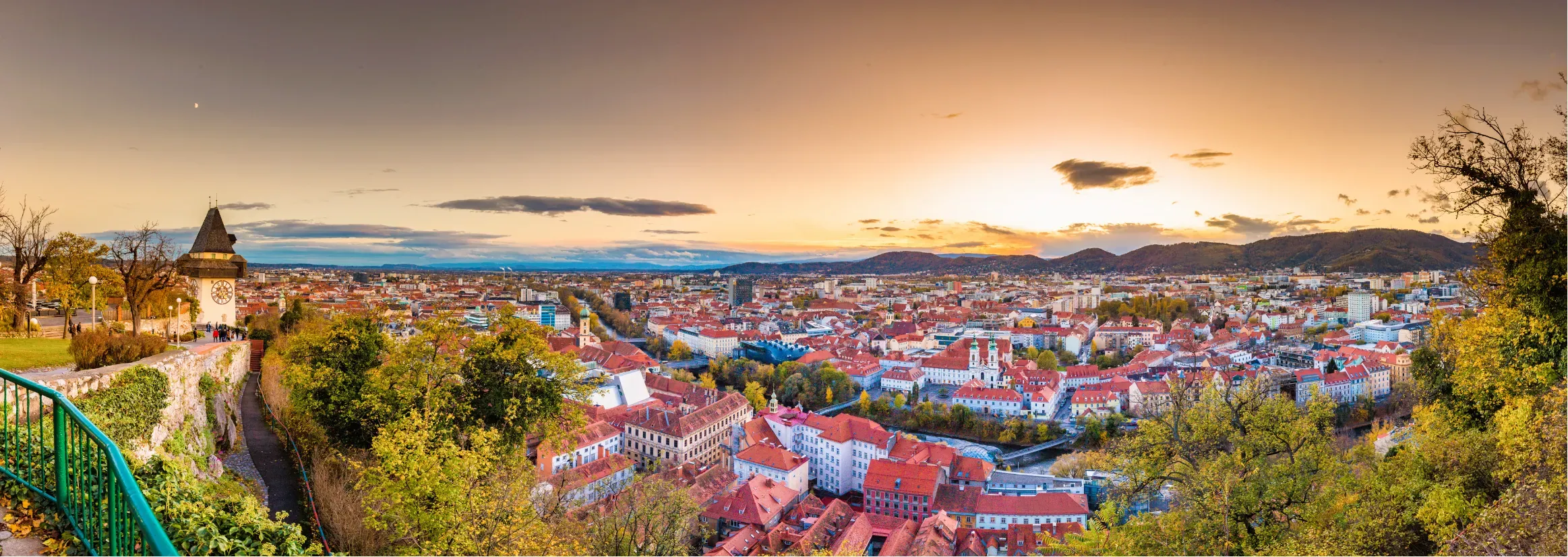
Current job openings
To explore tech roles in Graz, start here: TieTalent’s tech jobs. Filter by skills, seniority and contract type, then compare offers against the salary and cost-of-living sections above.
What is hiring in Graz right now
Graz’s tech economy is anchored by mobility engineering, electronics and climate tech, which creates steady demand for software, embedded, test and data roles.
- Automotive and e-mobility. Global players with sites around Graz include Magna and AVL, which regularly recruit engineers and software specialists across vehicle, battery and test systems.
- Electronics and secure systems. The Silicon Alps cluster connects companies and research in electronic and software based systems across Styria and Carinthia, with events and news that signal active hiring.
- Climate and circular solutions. Green Tech Valley positions the Graz region as a top European climate tech hub and highlights active firms and newcomers across energy, recycling and efficiency.
Tip for applicants
When roles mention “14 salaries,” that is standard in Austria. Confirm whether the quoted annual gross is paid in 12 or 14 instalments, and whether special payments are included in the stated figure. These extra payments are taxed preferentially up to one sixth of annual regular pay and remain subject to social contributions.
Income tax overview for Austria
Progressive rates for 2025
Austria taxes annual taxable income at progressive rates. For 2025 the brackets, adjusted for cold progression, are:
- up to €13,308 taxed at 0%
- €13,309 to €21,617 taxed at 20%
- €21,618 to €35,836 taxed at 30%
- €35,837 to €69,166 taxed at 40%
- €69,167 to €103,072 taxed at 48%
- €103,073 to €1,000,000 taxed at 50%
- above €1,000,000 taxed at 55% in 2025
Social security withheld from the payslip
Employee social contributions are withheld before income tax and cover health, pension, unemployment and minor items. 2025 reference rates for employees total about 18.07% up to the monthly assessment cap of €6,450 for regular pay. Special payments have their own lower contribution cap. Employer contributions are separate and higher.
13th and 14th salaries (special payments)
Most Austrian employees receive two extra monthly payments each year, typically in summer and at year end. These are taxed at a preferential rate up to one sixth of annual regular pay and remain subject to social contributions.
Useful tax reductions for families and commuters
- Family Bonus Plus reduces income tax by €2,000.16 per year per child under 18, and €700.08 per year per child after 18 if family allowance is received.
- Commuter allowance and Commuter Euro can lower the taxable base when traveling a set distance, with rules depending on the availability and reasonableness of public transport.
What Graz does not levy
There is no city income tax in Graz. Municipal payroll taxes exist but are paid by employers and are already reflected in standard offer calculations. National VAT and other indirect taxes apply to purchases.
TieTalent: Where Teams Are Formed. Join for Free!